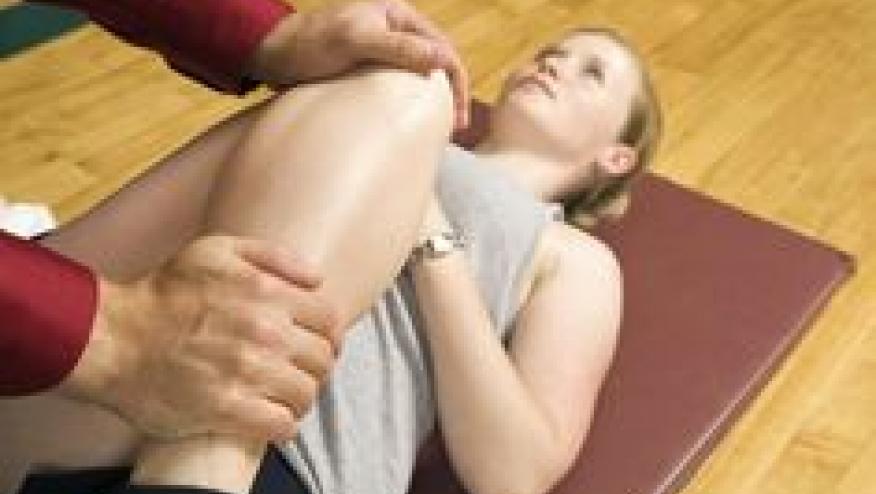Physical Therapy Underprescribed Save

Key Takeaways
- Guidelines for managing knee osteoarthritis (OA) call for recommending physical therapy in most cases.
- This study examined referral patterns at one large U.S. health system from 2016 to 2017.
- Just one-quarter of patients presenting with knee pain received physical therapy referrals at any point after an initial visit, with orthopedic surgeons the most likely to provide them.
Just one patient in six was referred for physical therapy (PT) within 15 days of being treated for knee pain at one major U.S. health system, researchers found, despite nearly universal consensus that PT should be recommended in most cases.
And three-quarters never received a PT referral at any point during the study period from 2016 to 2017, according to Samannaaz S. Khoja, PT, PhD, of the University of Pittsburgh, and colleagues. More commonly offered were intra-articular injections, opioids, and recommendations to use over-the-counter painkillers.
"Our findings align with previous studies that have shown that non-pharmacological approaches are underused relative to pharmacological approaches for KOA [knee osteoarthritis]," Khoja and colleagues wrote in Arthritis Care & Researcho. Even worse than the figures for PT referrals, they noted, patients' records showed that just 0.3% of patients were advised to make lifestyle modifications such as exercising more and eating healthier to lose weight.
"Despite its comparable or superior benefits relative to pharmacological approaches, PT, or exercise is under-prescribed as a frontline approach for KOA," the authors lamented.
All this, even though guidelines from nearly all the relevant professional societies recommend PT and at-home exercise as part of initial management for patients with knee OA (exceptions being patients with very advanced disease or other factors contraindicating increased exercise).
For example, guidance from the American College of Rheumatology and the Arthritis Foundation (ACR/AF) in 2019 gave a "strong recommendation" to exercise and noted too that "delivery of instruction by physical and occupational therapists is helpful, and often essential, for the appropriate initiation and maintenance of exercise as a part of OA management."
To get a sense of how much these official endorsements had penetrated into actual practice, Khoja and colleagues examined electronic records for patients seen over a 12-month period in 2016-2017 within the University of Pittsburgh's UPMC health system, which encompassed some 350 outpatient clinics in western Pennsylvania during that period. A total of 9,835 were identified as having a clinic visit for a new episode of knee pain. Their records were then checked for the 12 months following that visit for what referrals, recommendations, procedures, and prescriptions were provided.
Mean patient age was about 65 years and some three-quarters were overweight or obese. More than 60% were women. Self-reported pain ratings averaged about 6 on the standard 0-10 scale.
Of the overall cohort, 16.5% received an explicit referral for PT at the initial visit or within 15 days, and another 8.5% got one later either from their first physician or another in the UPMC system. It didn't seem to matter whether patients had an explicit OA diagnosis (about 38% of the total): an early PT referral was provided in 16.7% of that subgroup, compared with 16.3% of those with records merely indicating knee pain.
Meanwhile, some 41% of patients were advised to take non-steroidal anti-inflammatory drugs (NSAIDs) and 26% were offered "therapeutic injections." Astonishingly, 25% were given prescriptions for opioids more potent than tramadol, the researchers found. "While use of NSAIDs is guideline-concordant, the use of non-tramadol narcotics during early KOA management is concerning as the most recent ACR/AF guidelines conditionally recommend against their use," Khoja's group commented.
Referral patterns varied somewhat with physician specialty and other factors. Orthopedic surgeons were more likely than primary care doctors or other specialists to make PT referrals; Khoja and colleagues speculated that orthopedists may be more attuned to guidelines on knee OA, and/or more likely to recognize patients for whom other approaches such as surgery aren't appropriate. On the other hand, orthopedists were also the biggest non-tramadol opioid prescribers, though mostly at follow-up visits.
Women were 43% more likely than men to be referred for PT. Providers in rural areas were 35% less likely to make PT referrals than their colleagues in urban locations, and lower referral rates were also seen in areas where PT providers were relatively scarce (<10 per 10,000 population). And increasing BMI was linked with higher PT referral probability, while increasing pain had the opposite association.
Limitations included the reliance on administrative data, which may be erroneous and would not capture recommendations that clinicians may have made orally without entering them into the electronic records. Clinicians' reasoning in making or withholding referrals could not be fully known, either. Finally, the focus on one health system in one part of one state may limit the generalizability of the study results.
Source Reference: Khoja SS, et al "Physician referral patterns to physical therapists for managing knee osteoarthritis: a retrospective analysis of electronic health records from an integrated health system" Arthritis Care Res 2025; DOI: 10.1002/acr.25630.

Disclosures
The study was funded by the Foundation for Physical Therapy's Center on Health Services Training and Research, the Academy of Orthopedic Physical Therapy, and the National Institutes of Health.
Study authors declared they had no relevant relationships with commercial entities.









If you are a health practitioner, you may Login/Register to comment.
Due to the nature of these comment forums, only health practitioners are allowed to comment at this time.